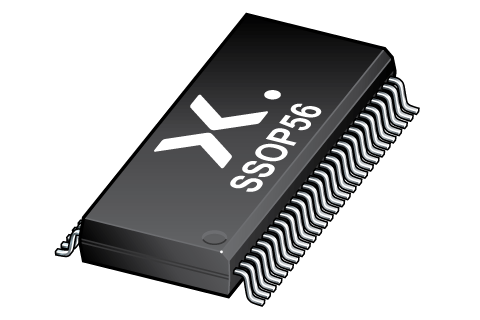
Register once, drag and drop ECAD models into your CAD tool and speed up your design.
Click here for more information74ALVT162823DL
18-bit bus-interface D-type flip-flop with reset and enable with 30 Ohm termination resistors; 3-state
The 74ALVT162823 18-bit bus interface register is designed to eliminate the extra packages required to buffer existing registers and provide extra data width for wider data or address paths of buses carrying parity.
The 74ALVT162823 has two 9-bit wide buffered registers with clock enable (nCE) and master reset (nMR) which are ideal for parity bus interfacing in high microprogrammed systems.
The registers are fully edge-triggered. The state of each D input, one set-up time before the LOW-to-HIGH clock transition is transferred to the corresponding Q output of the flip-flop.
The 74ALVT162823 is designed with 30 Ω series resistance in both the pull-up and pull-down output structures. This design reduces line noise in applications such as memory address drivers, clock drivers, and bus receivers or transmitters.
Features and benefits
Two sets of high speed parallel registers with positive edge-triggered D-type flip-flops
5 V I/O compatible
Ideal where high speed, light loading or increased fan-in are required with MOS microprocessors
Bus hold data inputs eliminate the need for external pull-up resistors to hold unused inputs
Live insertion and extraction permitted
Power-up 3-state
Power-up reset
Output capability: +12 mA to -12 mA
Outputs include series resistance of 30 Ω making external termination resistors unnecessary
Latch-up protection:
JESD78: exceeds 500 mA
ESD protection:
MIL STD 883, method 3015: exceeds 2000 V
Machine Model: exceeds 200 V
Applications
Parametrics
| Type number | Product status | Package name |
|---|---|---|
| 74ALVT162823DL | End of life | SSOP56 |
Package
All type numbers in the table below are discontinued. See the table Discontinuation information for more information.
| Type number | Orderable part number, (Ordering code (12NC)) | Status | Marking | Package | Package information | Reflow-/Wave soldering | Packing |
|---|---|---|---|---|---|---|---|
| 74ALVT162823DL | 74ALVT162823DL,112 (935261659112) |
Obsolete | ALVT162823 Standard Procedure Standard Procedure |

SSOP56 (SOT371-1) |
SOT371-1 |
SSOP-TSSOP-VSO-REFLOW
SSOP-TSSOP-VSO-WAVE |
Not available |
| 74ALVT162823DL,118 (935261659118) |
Obsolete | ALVT162823 Standard Procedure Standard Procedure | Not available | ||||
| 74ALVT162823DL,512 (935261659512) |
Obsolete | ALVT162823 Standard Procedure Standard Procedure | Not available | ||||
| 74ALVT162823DL,518 (935261659518) |
Obsolete | ALVT162823 Standard Procedure Standard Procedure | Not available |
Environmental information
All type numbers in the table below are discontinued. See the table Discontinuation information for more information.
Series
Documentation (7)
| File name | Title | Type | Date |
|---|---|---|---|
| 74ALVT162823 | 18-bit bus-interface D-type flip-flop with reset and enable with 30 Ohm termination resistors; 3-state | Data sheet | 2018-01-23 |
| alvt162823 | alvt162823 IBIS model | IBIS model | 2013-04-07 |
| Nexperia_package_poster | Nexperia package poster | Leaflet | 2020-05-15 |
| SOT371-1 | plastic, shrink small outline package; 56 leads; 0.635 mm pitch; 18.45 mm x 7.5 mm x 2.8 mm body | Package information | 2020-04-21 |
| SSOP-TSSOP-VSO-REFLOW | Footprint for reflow soldering | Reflow soldering | 2009-10-08 |
| alvt16 | alvt16 Spice model | SPICE model | 2013-05-06 |
| SSOP-TSSOP-VSO-WAVE | Footprint for wave soldering | Wave soldering | 2009-10-08 |
Support
If you are in need of design/technical support, let us know and fill in the answer form we'll get back to you shortly.
Models
| File name | Title | Type | Date |
|---|---|---|---|
| alvt162823 | alvt162823 IBIS model | IBIS model | 2013-04-07 |
| alvt16 | alvt16 Spice model | SPICE model | 2013-05-06 |
How does it work?
The interactive datasheets are based on the Nexperia MOSFET precision electrothermal models. With our interactive datasheets you can simply specify your own conditions interactively. Start by changing the values of the conditions. You can do this by using the sliders in the condition fields. By dragging the sliders you will see how the MOSFET will perform at the new conditions set.
